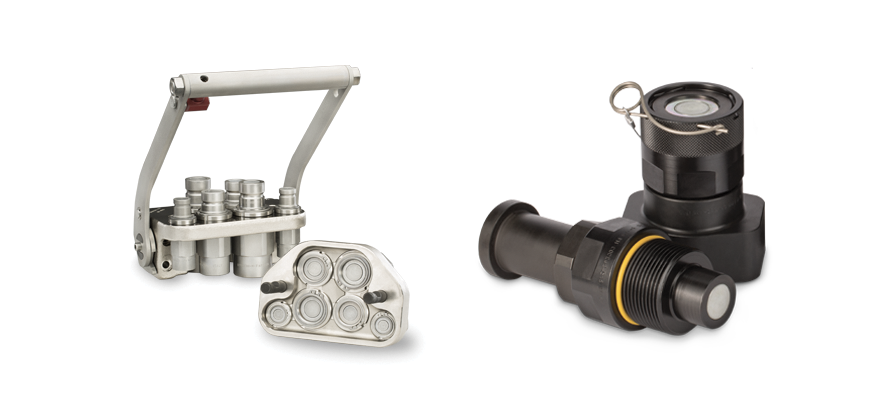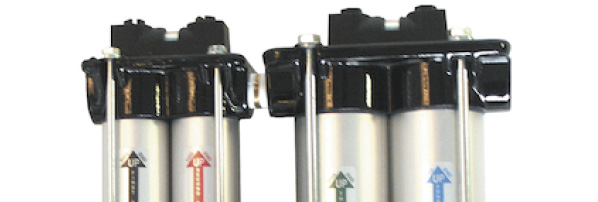Hydraulics & Demolition

Improve Efficiency, Safety, and Profitability in High-Reach and Highway/Bridge Demolition
By Scott Rolston, President, Stucchi, Inc..
The demolition industry has undergone significant transformations, from manual wrecking ball methods to advanced hydraulic-powered techniques. Hydraulic systems are pivotal in modern demolition processes, ensuring safety, efficiency, and precision. Maintaining reliable hydraulic connections with durable quick couplings that withstand heavy-duty processes under pressure is key to achieving maximum productivity and profitability.
Methods of Demolition
There are various methods of demolition and types of machinery and equipment used depending on the type of demolition application. The primitive image of a wrecking ball may come to mind. However, popular from the 1930s to the 70s, this antiquated demolition method has been replaced with long-reach excavators and hydraulic attachments. Excavators and hydraulic fluid power bring greater efficiency, precision, and safety to modern demolition processes.
Mechanical demolition utilizes specialized equipment and tools, such as excavators with long booms and attachments designed to break down concrete and steel structures. Smaller equipment like skid steer loaders and demolition robots are used for more precise and selective demolition tasks.
Implosion is a highly specialized method that employs explosives to bring down tall structures by undermining their structural supports, causing the building to collapse within its footprint or along a predetermined path. Implosion is used in less than 1% of demolition projects due to its complexity and safety concerns.
Types of Demolition
There are many different types of demolition, such as commercial, industrial, interior, deconstruction, high-reach demolition, and demolition of highways and bridges. Deconstruction is a specialized type of demolition that is more labor-intensive and focused on preserving recyclable materials. High-reach demolition and demolition of bridges and highways require excavators with long booms and various attachments to demolish tall structures safely and precisely.
High-Reach Demolition
High-reach demolition is a specialized method for dismantling tall and structurally complex buildings, often 20 stories or more. These structures may consist of steel, masonry, and concrete, making traditional demolition methods impractical. High-reach demolition relies on high-reach excavators with long booms and specialized attachments to dismantle buildings from the top down. This approach ensures safety and precision, particularly when adjacent structures must remain intact.
High-reach booms with specialized hydraulic attachments mounted on excavator platforms are designed to reach tall structures. High-reach booms allow for careful and controlled demolition, which is crucial in urban areas. This increases safe demolition processes.
High-reach booms with attachments contribute to the need for recycling and processing debris with efficiency and less labor than required years ago. Using multiple attachments on one mobile equipment base and quick-changing hydraulic attachments greatly increases efficiency and productivity.
With the right attachments and proper maintenance of auxiliary hydraulics, demolition contractors can achieve many benefits, including:
- Reduced time spent on-site
- Reduced costs
- Increased safety
- Increased recycling efforts
- Increased productivity
- Improved profitability
Choosing the Right Attachments in High-Reach Demolition
Demolition crews must have the appropriate attachment selection to perform various tasks common to many demolition sites. The application should be the first factor to guide an attachment choice. The choice depends on the type of material and how it must be broken up. An example would be primary to secondary demolition and rebar-enforced concrete compared to wood or brick structures.
When demolishing a structure, primary picks include multi-processors, shears, hydraulic breakers, demolition grapples, pulverizers, and crushers. Crusher and pulverizer attachments are the best tackle jobs made up of mostly concrete. For concrete structures, contractors will use multi-processors, hammers, and secondary pulverizers for primary and secondary demolition.
If concrete isn’t part of the demolition but steel is, a demolition processor with shear jaws or a mobile shear attachment is best practice. For heavy steel structure demolition, contractors often use demolition shears or a multi-processor with shear jaws to utilize scrap.
A hydraulic breaker is often a good choice for tackling rock or large-scale demolition projects. Many contractors use a demolition grapple when working with light materials such as wood and brick, commonly found in residential demolition.
Besides breaking apart materials, rotating grapples work well for sorting during secondary demolition and increase versatility and productivity by allowing a wide range of movement. Ultimately, the use of attachments serves the contractor in efficiency and productivity.
Hydraulic Hammers, Shears, and Processors
Hammers (Hydraulic Breakers): Hydraulic breakers, commonly known as hammers, are crucial and perhaps the most commonly used attachments on a demolition site. They quickly deliver high-breaking force to demolish concrete, pavement, and rock. These breakers are also used for trenching tasks. Hydraulic breakers are indispensable tools in high-reach demolition and other demolition processes.
They offer several advantages:
- High breaking force: Hydraulic breakers can power through materials quickly, making them essential for breaking concrete, pavement, and rock.
- Minimal maintenance: These breakers require minimal routine maintenance, ensuring cost-effectiveness and minimal downtime on the job.
- Adaptability: Hydraulic breakers can be used on various demolition equipment, from large excavators to mini-excavators and compact loaders.
- Improved technology: Innovations have led to hydraulic breakers providing 2 to 3 times more blows per minute (BPM), enhancing efficiency.
Shears: Shears are used to cut through materials like steel and concrete. They can rotate 360 degrees for horizontal, vertical, and angled cuts, making them versatile tools for high-reach demolition projects.
Processors: Processors are designed to break down materials into smaller pieces, such as gravel. They are vital in reducing debris size for easier disposal or recycling.
Durable Hydraulic Quick Couplings Support High-Reach Demolition
Hydraulics support high-reach demolition processes and must maintain a reliable fluid power supply when booms are extended to power attachments like hydraulic hammers and shears. The hydraulic system, including durable auxiliary hydraulic quick couplings, is crucial to maintaining the power required for these heavy-duty processes. Durable auxiliary hydraulic couplers are just as important during attachment changeovers and when operators must tear down the equipment to transport it.
Auxiliary hydraulic quick couplings must maintain their performance without premature wear, which can lead to unexpected equipment maintenance and unplanned downtime. Unexpected maintenance and downtime are profit killers in demolition jobs, which are always on a tight schedule.
Highway & Bridge Demolition
Demolishing highways and bridges requires meticulous planning and the use of specialized equipment. Unlike the stereotypical image of wrecking balls or explosives, highway and bridge demolition primarily rely on hydraulic excavators equipped with attachments for concrete removal and girder dismantling.
Engineering Analysis in Highway & Bridge Demolition
Demolishing structures like highway overpass bridges demands the same thorough engineering analysis as required during the construction phase. This analysis considers factors like excavator positions, demolition stages, excavator body weight, and the weight of hammer tips. Additionally, engineering work is required for crane support design, pick plans, pick weights, and rigging design when cranes are used for demolition. Auxiliary quick couplings and multi-coupling plates support high-reach bridge demolition for safe and efficient processes and help crane operators quickly set up and tear down equipment for peak performance.
Equipment Used in Highway & Bridge Demolition
Highway and bridge demolition primarily relies on excavators and cranes, with the following tools:
Excavators: Equipped with hydraulic hammers or shears, excavators are essential for concrete removal and girder dismantling.
Hydraulic Hammers or Shears: These attachments are used to break concrete and remove sections of the structure.
Cranes: Cranes are crucial in lifting and removing heavy structural components like girders.
The Role of Hydraulic Connections in Demolition
Hydraulic systems provide the power needed for modern demolition equipment to operate attachments and perform precise and controlled demolitions. In high-reach and highway/bridge demolition, hydraulic connections are a critical equipment component. These connections ensure the seamless flow of hydraulic fluid to power various attachments and perform the necessary tasks.
Operators must often switch between these attachments without jeopardizing hydraulic hoses, damaging couplers, or leaking fluid. This is where quality hydraulic connections and quick couplers come into play. High-quality, durable auxiliary hydraulic quick couplings prevent premature wear and damage, reducing maintenance, preventing downtime, and providing many advantages to demolition contractors.
Importance of Hydraulic Quick Couplers and Auxiliary Couplings
Hydraulics are the lifeblood of excavators used in demolition applications. Hydraulics can be used to power the connection and disconnection of attachments, replacing manual quick couplers to do the job effortlessly and in a fraction of the time. Where multiple attachments may be used on a single equipment base, the ability to switch between attachments rapidly is crucial to meeting deadlines and operating profitably.
This type of hydraulic quick coupler is different from hydraulic quick couplings, which connect hydraulic hoses; these quick couplings are referred to as auxiliary quick couplings in excavator applications not to be confused with the quick coupler to connect and disconnect attachments.
Here are some key reasons why durable hydraulic quick couplers are vital in demolition:
- Increased Efficiency: Operators equipped with quality hydraulic quick couplers can switch between attachments in as little as one minute, compared to ten minutes or more with manual connections. This rapid attachment changeover significantly enhances efficiency.
- Support for Versatility: Demolition job sites often require various attachments to tackle different tasks efficiently. Hydraulic quick couplers support the versatility needed for excavator operators to switch between attachments confidently, making demolition operations more efficient and utilizing various tools on one equipment base.
- Improved Safety: Minimizing time outside the excavator cab enhances job site safety. Quick and efficient attachment changeover reduces the operator’s exposure to potentially hazardous hydraulic work tools, often heavy and under high pressure.
- Prevention of Contamination: Hydraulic fluid leaks pose risks to workers and the environment. Threaded, flat-face quick couplers, such as those designed by Stucchi, offer protection against fluid leaks and contamination of the hydraulic circuit.
Hydraulic quick couplings are also used to connect the fluid power hoses in the auxiliary hydraulic system that powers the attachments during use. Both hydraulic systems are critical to perform safe and efficient demolition work. The hydraulic system of excavators during demolition work is often under high pressure or experiences high-pressure impulses. It is important to use auxiliary hydraulic quick couplings designed to connect and disconnect under pressure easily and without fluid spillage.
Be sure to speak with an experienced hydraulic quick-connect specialist to achieve maximum safety, efficiency, and productivity in demanding demolition applications.








